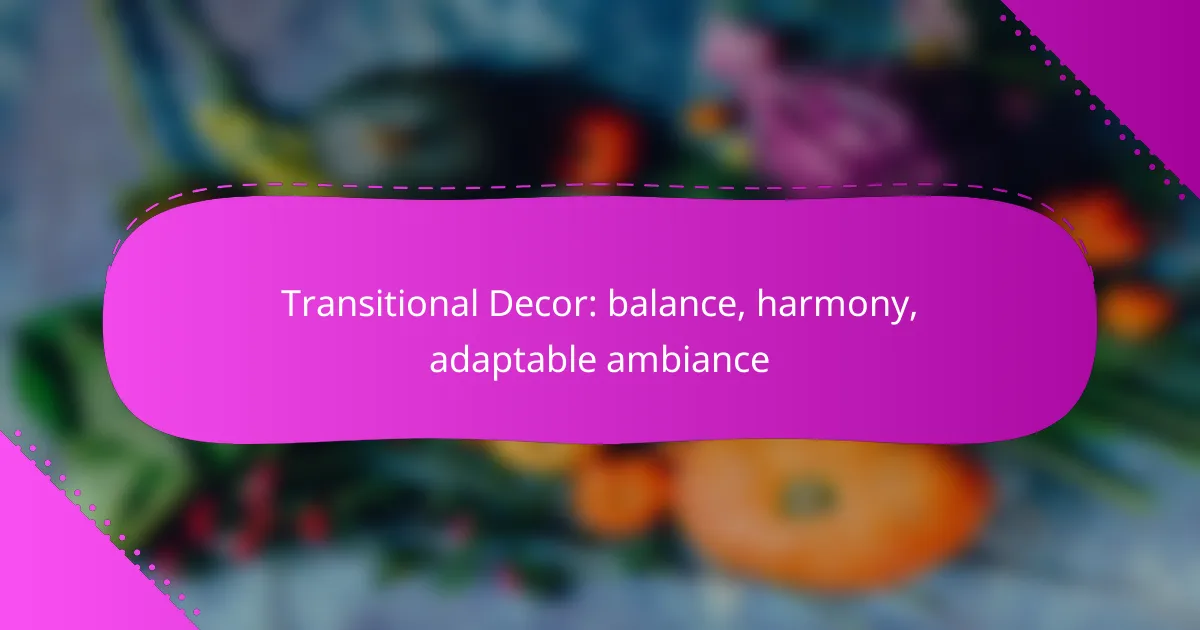Transitional decor artfully merges traditional and modern design elements to create a balanced and harmonious ambiance. By carefully selecting colors, materials, and furnishings, this style emphasizes adaptability while prioritizing comfort and functionality, resulting in a cohesive and inviting space.

How to achieve balance in transitional decor?
Achieving balance in transitional decor involves blending elements from both traditional and modern styles to create a harmonious environment. Focus on maintaining a cohesive look through careful selection of colors, materials, and furnishings that complement each other.
Use neutral color palettes
Neutral color palettes are essential in transitional decor as they provide a calming backdrop that allows other design elements to shine. Shades like beige, gray, and soft whites can create a cohesive flow throughout the space.
To achieve balance, consider using a mix of warm and cool neutrals. For instance, pairing warm beige with cool gray can add depth while maintaining a serene atmosphere. Accent colors can be introduced through accessories like cushions or artwork to add interest without overwhelming the space.
Incorporate natural materials
Natural materials play a crucial role in creating a balanced and inviting transitional decor. Wood, stone, and textiles like linen or cotton can add warmth and texture, bridging the gap between modern and traditional styles.
For example, a reclaimed wood coffee table can serve as a focal point while complementing sleek, contemporary furniture. Incorporating plants or natural fibers can further enhance the ambiance, promoting a sense of tranquility and connection to nature.
Mix modern and traditional elements
Mixing modern and traditional elements is key to achieving balance in transitional decor. This approach allows for a dynamic interplay between different styles, creating a unique and personalized space.
Consider pairing a contemporary sofa with vintage side tables or a traditional rug under a modern dining table. This juxtaposition not only adds character but also ensures that no single style dominates the space, fostering a sense of harmony.

What are the key features of transitional decor?
Transitional decor combines elements of both classic and contemporary styles, creating a balanced and harmonious ambiance. This approach emphasizes adaptability, allowing for a seamless integration of various design elements while prioritizing comfort and functionality.
Blend of classic and contemporary styles
Transitional decor is characterized by its unique blend of traditional and modern design elements. This fusion often includes classic furniture pieces with contemporary finishes, such as a vintage armchair upholstered in a sleek fabric. The goal is to create a cohesive look that feels both timeless and current.
When selecting items for transitional spaces, consider neutral color palettes that can easily accommodate both styles. Soft grays, taupes, and whites serve as a perfect backdrop, allowing for the introduction of bolder accents through accessories or artwork.
Focus on comfort and functionality
Comfort and functionality are central to transitional decor, ensuring that spaces are not only visually appealing but also livable. Furniture should be inviting and practical, such as a plush sofa that encourages relaxation while fitting seamlessly into the overall design scheme.
To achieve this balance, prioritize multi-functional pieces, like ottomans that serve as both seating and storage. Additionally, ensure that layouts promote easy movement and accessibility, making the space welcoming for both residents and guests.

How to create harmony in a transitional space?
To create harmony in a transitional space, blend traditional and contemporary elements seamlessly. Focus on balanced proportions, a cohesive color palette, and a mix of textures to foster an adaptable ambiance.
Utilize cohesive design elements
Cohesive design elements are essential for achieving harmony in transitional decor. Start by selecting a unifying color scheme that incorporates both warm and cool tones, allowing for versatility across different styles. Aim for a balance of materials, such as wood, metal, and fabric, to create visual interest without overwhelming the space.
Consider incorporating furniture pieces that reflect both traditional craftsmanship and modern lines. For example, a classic wooden dining table paired with contemporary chairs can effectively bridge the gap between styles. Accessories like artwork and decorative items should also reflect this blend, ensuring they complement rather than clash with each other.
Incorporate layered lighting
Layered lighting is crucial for enhancing the ambiance in a transitional space. Utilize a combination of ambient, task, and accent lighting to create depth and warmth. For instance, overhead fixtures can provide general illumination, while table lamps and wall sconces offer focused light for specific tasks or areas.
When selecting light fixtures, choose designs that harmonize with both traditional and modern aesthetics. A vintage chandelier can coexist beautifully with sleek floor lamps, creating a dynamic yet cohesive atmosphere. Remember to consider dimmers for flexibility, allowing you to adjust the lighting according to the time of day or mood.

What are the best materials for transitional decor?
The best materials for transitional decor blend traditional and contemporary styles, creating a balanced and harmonious ambiance. Key materials include wood, metal, and soft textiles, which together enhance adaptability and comfort in various spaces.
Wood and metal combinations
Combining wood and metal is a hallmark of transitional decor, offering a striking contrast that adds depth to your space. For instance, pairing a sleek metal frame with a warm wooden table creates visual interest while maintaining a cohesive look.
When selecting wood and metal combinations, consider finishes that complement each other. Light woods like oak or maple work well with brushed nickel or matte black metals, while darker woods like walnut can pair beautifully with polished brass or copper accents.
Soft textiles like linen and cotton
Soft textiles such as linen and cotton are essential in transitional decor, providing comfort and warmth. These materials are versatile and can be used for upholstery, curtains, and cushions, allowing for easy updates to your decor without a complete overhaul.
When choosing textiles, opt for neutral colors or subtle patterns that enhance the overall aesthetic. Fabrics in muted tones can help create a serene environment, while textures like linen add a touch of sophistication. Regularly incorporating these textiles into your decor can keep your space feeling fresh and inviting.

How to choose furniture for transitional decor?
Choosing furniture for transitional decor involves selecting pieces that blend traditional and contemporary styles, creating a balanced and harmonious ambiance. Focus on versatility, quality, and adaptability to ensure your space remains inviting and functional.
Select versatile pieces
Versatile furniture is essential for transitional decor as it allows for easy adaptation to different styles and settings. Look for items that can serve multiple purposes, such as a coffee table that doubles as storage or a sofa bed for accommodating guests.
Consider neutral colors and classic shapes that can complement various design elements. For example, a beige sectional can seamlessly fit into both modern and traditional environments, making it a practical choice.
Prioritize quality craftsmanship
Quality craftsmanship is crucial in transitional decor, as it ensures durability and longevity. Invest in well-made furniture that features solid construction, such as hardwood frames and high-quality upholstery, which can withstand daily use.
Examine details like stitching, joinery, and finishes to assess quality. A well-crafted piece not only enhances the aesthetic appeal but also adds value to your home, making it a wise investment in the long run.

What are popular color schemes for transitional decor in the UK?
Popular color schemes for transitional decor in the UK often blend traditional and contemporary elements, creating a balanced and harmonious ambiance. Soft greys, whites, and earthy tones with vibrant accents are frequently used to achieve this adaptable style.
Soft greys and whites
Soft greys and whites serve as a versatile foundation for transitional decor, providing a neutral backdrop that enhances light and space. These colors can be used on walls, furniture, and textiles, allowing for easy integration with various design elements.
When selecting shades, consider using warm greys to create a cozy atmosphere or cooler tones for a more modern feel. Pairing these colors with natural materials like wood or stone can further enhance the overall aesthetic.
Earthy tones with pops of color
Earthy tones, such as taupe, beige, and muted greens, add warmth and depth to transitional spaces. These colors evoke a sense of nature and tranquility, making them ideal for creating a welcoming environment.
To inject personality, incorporate pops of color through accessories like cushions, artwork, or decorative items. Bright hues like mustard yellow or deep teal can provide striking contrasts, ensuring the decor remains dynamic and engaging.

How to accessorize transitional decor effectively?
Accessorizing transitional decor involves blending traditional and contemporary elements to create a cohesive and inviting space. Focus on selecting accessories that enhance balance and harmony while allowing for adaptability in style.
Choose a Balanced Color Palette
Select a color scheme that combines neutral tones with pops of color to maintain a balanced look. Soft grays, beiges, and whites can serve as a base, while rich hues like navy or emerald can add depth and interest.
Consider using accessories such as cushions, artwork, or decorative vases in these accent colors. This approach allows for easy updates as trends change, keeping your decor fresh without a complete overhaul.
Incorporate Textures and Materials
Mixing various textures and materials is key to achieving a transitional look. Combine soft fabrics like linen or velvet with harder surfaces such as wood or metal to create visual contrast.
For example, a plush area rug can complement a sleek coffee table, while textured throw pillows can enhance a smooth sofa. This interplay of materials adds depth and makes the space feel inviting.
Utilize Functional Accessories
Functional accessories not only serve a purpose but also contribute to the overall aesthetic. Items like stylish storage baskets, decorative trays, or elegant lighting fixtures can enhance both form and function.
Choose accessories that reflect your personal style while maintaining the transitional theme. For instance, a modern lamp can provide illumination while adding a contemporary touch to a traditional setting.
Layering and Arrangement Techniques
Layering accessories creates depth and interest in transitional decor. Use varying heights and sizes when arranging items on shelves or tables to avoid a flat appearance.
Consider grouping accessories in odd numbers for a more dynamic look. For example, a trio of decorative objects or a combination of different-sized frames can create an engaging focal point.
